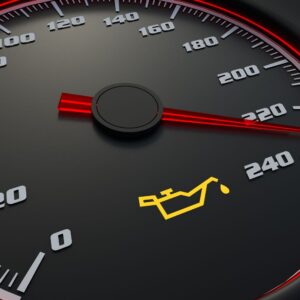A modern vehicle is equipped with several sensors that help monitor the condition of some of its most critical components. These sensors send their data to the powertrain control module (PCM). The PCM then alerts the driver accordingly through the instrument panel cluster. One example of a warning light is the “check gauges” light.
What Does the Check Gauge Light Mean?
This warning light means that one or several gauge readings aren’t within the normal range.
It can also mean that certain readings are reaching hazardous levels. For example, the check gauge light can illuminate once the PCM detects the temperature of your coolant is too high. However, take note that not all vehicles have a temperature gauge. Some only have a warning light that’s triggered when the temperature is too high. You’ll know which gauge is causing it because the affected gauge will also illuminate at the same time as the warning light.
The check gauge light is usually triggered once the PCM detects something reading that’s outside normal parameters. These readings include:
- Coolant Temperature
- Engine RPM
- Fuel Level
- Oil Pressure
- Transmission temperature
- Tire Pressure
- Wheel Speed
- Voltmeter
Common Triggers of the Check Gauges Light
Here are some issues that can illuminate the check gauge light:
Low Oil Pressure
A check gauge light can be a sign that your vehicle’s oil pressure is low. The oil pressure warning light will usually illuminate along with the check gauge warning light.
There can be many reasons why your ride’s oil pressure readings are low. One of the common is an oil filter leak. A bad oil pressure sensor and a leaking oil pressure sender can also be the culprit.

Loose Gas Cap
Your gas cap is a crucial component of your vehicle because it keeps fuel vapors from escaping. It basically seals your fuel system. Once it becomes loose, it can trigger both your check engine light and check gauges light to come on.
Fixing this issue is quite easy. You’ll just have to tighten the cap or replace the cap’s O-ring. In some cases, you’ll need to replace the actual gas cap.
Thermostat Issues
A faulty thermostat won’t be able to regulate coolant flow effectively. Once coolant flow is disrupted, your vehicle can overheat. This can trigger the check gauge light and other warning lights on your dash as well.
Remember that frequent engine overheating can damage the components in your engine. So don’t think twice about taking a trip to the repair shop once you suspect a thermostat problem.
Vacuum Leak
A vacuum leak can cause unusually high RPMs. This will trigger the check gauge light to turn on. Some diagnostic trouble codes (DTCs) will also be logged once this happens.
Incorrect Tire Pressure
Modern vehicles are equipped with sensors to monitor the pressure of your tires. Once the sensors detect that the pressure gets too low or high, it’ll trigger the tire pressure warning light to come on. The check gauge light can also illuminate.
In vehicles equipped with TPMS (tire pressuring monitoring system), a TPMS light that starts flashing and continuously illuminates afterwards points to a sensor issue in one of your tires. If you start the vehicle and the light immediately turns on without flashing or blinking, then you are most likely dealing with low pressure in one or several tires.
In vehicles equipped with TPMS (tire pressuring monitoring system), a TPMS light that starts flashing and continuously illuminates afterwards points to a sensor issue in one of your tires.
–Anthony Harlin, ASE Certified Master Automobile Technician
To know the recommended tire pressure for your vehicle, you can reference the TPMS placard on your driver door jamb.
Bad Engine Ground
A check gauge light can also be caused by poor ground between the engine and the chassis. Once one of the ground wires running between them gets corroded, it can create connection issues. Once there’s a bad ground, the sensors in the engine might not be able to send correct readings to the PCM, triggering the check gauge light.
Aside from the underlying issues mentioned above, there can be other reasons why the check gauge light illuminates. It’s important to be able to pinpoint the issue and resolve it in order to get rid of this warning light.
What Does the Check Gauges Light Look Like?
The words “Check Gauge” will usually appear or flash on your dash. The exact color and appearance of the check gauge light will depend on your ride’s specific make and model. In some applications, the color of the light can signal how severe the problem is.
Is It Safe to Drive with a Check Gauge Light On?
Technically, you can still drive your vehicle even if the check gauge light is on. But depending on what’s causing the issue, your vehicle can eventually break down.
Whether it’s safe to drive your car or not depends on which gauge has hazardous readings. For example, if the gauge says that your coolant temperature is beyond normal parameters, the safest thing to do is to find a place to stop the car because your engine is likely overheating.
Why Does My Check Gauge Light Come On and Off?
A check gauge light that comes on and off usually indicates a problem with the sensors or the sending unit. In some cases, you can be dealing with a malfunctioning PCM. Let a mechanic diagnose the issue right away to avoid getting stuck on the road.
Can I Prevent the Check Gauges Light from Coming On?
It’s unavoidable for a vehicle to have issues as it gains mileage. However, you can prevent unnecessary issues by simply following your ride’s maintenance schedule. These maintenance time frames are set by your manufacturer for a reason.
If you ignore your regular maintenance checks, you might not be able to change clogged filters and contaminated oil. This can cause a plethora of other issues aside from the check gauge light.
Any information provided on this Website is for informational purposes only and is not intended to replace consultation with a professional mechanic. The accuracy and timeliness of the information may change from the time of publication.



















